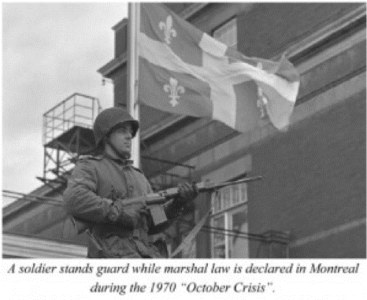
By Matthew Ehret
The following two part series was co-written with Paris-based journalist Benoit Chalifoux and myself (first published in Canadian Patriot #4 in 2013) documenting the inside job run by Anglo-Canadian intelligence networks during the first Trudeau dictatorship of Canada in October 1970.
Due to the current activation of the Emergency Measures Act by Justin Trudeau on February 14 in response to the Freedom Convoys and blockades both in Ottawa and across various provinces of Canada, I thought it fitting to republish the text in full here. Where part one deals with some important contextual backstory, part two breaks down the facts of the October Crisis inside job itself.
It is also worth noting that the driving force behind the border blockades and the Ottawa protests which are spreading across the world are not the same process. Facts on the ground in Windsor and Manitoba demonstrate that unlike the freedom convoy, the border blockades are not organic and carrying many signatures of stage managed operations put on with a complicit media and fools to justify such an unjustifiable crackdown.
Sovereignty or Technocracy: A Tale of Two Revolutions
Until 1947, Canada was known as “The Dominion of Canada”. While its title of “Dominion” has changed, Canada is still not an independent nation, but a Monarchy ruled by the British Queen and Privy Council. Until the 1960s, the French Canadians, who form the overwhelming majority of the population of Quebec, were in the main confined to manual labour and low-level clerical jobs, while the upper echelons of society were occupied by the descendants of the British colonial elite. The question for honest leaders in Quebec at that time was “How can a society so long kept economically and culturally underdeveloped be brought into a state of self-government, skills and dignity”?
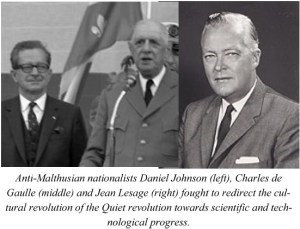
Faced with that conundrum, Quebec Premiers Paul Sauvé (1959), Jean Lesage (Liberal Party 1960-65) and Daniel Johnson Sr. (Union nationale 1966-68) had, between 1959 and 1968, instituted policies that had led to a great economic revolution in Quebec centered on scientific and technological progress. This was done by the creation of an advanced engineering culture of Quebec and an international outlook towards ending colonialism under French President Charles de Gaulle’s leadership.
This was, however only one current that shaped the 1959-68 period of Quebec. There was a second, much more evil current that also shaped that period. WIthout an understanding of both currents, then no comprehension of the true purpose of the October crisis of 1970 and its effects were at all possible.
The Deconstruction and Reconstruction of Society
The De Gaulle-Johnson-Lesage nation-building momentum had been an inspired attempt to outflank the British Malthusian movement that was then attempting to impose the program which Fabian Society leader H.G. Wells described in detail in his 1930 book the “New World Order” of depopulation, eugenics, and one world government. In his book, H.G. Wells states:
“It is the system of nationalist individualism that has to go… We are living in the end of the sovereign states… In the great struggle to evoke a westernized World Socialism, contemporary governments may vanish….Countless people…will hate the new world order….and will die protesting against it.”
Later on, in 1932, Wells, ever the devout eugenicist stated that all progressives and social reformers must become “liberal fascisti… enlightened nazis.”
The strategy of the synarchist figures who ran both the October Crisis and the secularization of Quebec was to bring society under a system of perfect predictability and control outlined by Wells and other Fabian socialists decades earlier. For this deconstruction of pre-existing values to occur, Wells and other Fabian thinkers reasoned that society would have to be purged of its traditional Judeo-Christian values, love for the general welfare, and especially scientific and technological progress. In this sense, all forms of individualism that Wells refers to, which are in harmony with patriotic nationalism are simply causes of uncertainty and uncontrollable change in the mind of a social engineer and hence must be purged. Only a materialist society motivated by selfish impulses under a system of fixed resources can be controlled in a predetermined fashion. The outcome of this social purging came later to be known as the “rock-drug-sex baby boomer counterculture”. Quebec, during this period was a battleground for the soul of western civilization.
Using the hypocrisies and corruption in the old Duplessis order as a moral lever to direct social anger towards the existing established order, the social engineering program that had been gaining steam from 1946-1960 under the control of Georges-Henri Levesque at the Université Laval, blew up with what had later come to be dubbed the `Quiet Revolution`.
While the nation-builders attempted to guide this transformation into a constructive direction, terrorist separatist groups such as the FLQ were created throughout the 1960s leading to the implementation of the War Measures Act on October 16th 1970, and then to the Emergency Measures Act under the leadership of Fabian Socialist Pierre Elliot Trudeau (Trudeau had been recruited to the Fabian Society under his tutelage of Fabian Leader Harold Laski at the London School of Economics from 1947-49 before being set up in the Ottawa Privy Council Office which has been a control center of Canada since Confederation). The latter act, somewhat less drastic than the War Measures Act, was voted up by the Canadian Parliament on December 1st 1970, and remained in force for five months.
Introducing Pierre Vallières
Many of the resources utilized in the following report are derived from a book written by a journalist called Pierre Vallières, L’exécution de Pierre Laporte, les dessous de operation Essai (Editions Quebec-Amériques, 1977). Beyond what he writes in this book, Pierre Vallières himself is an important clue in the true story behind the true top down agenda of the Synarchy which organized the various intelligence organizations that effectively ran the October crisis.
Vallières was a major player in the events of October 1970. He came from the separatist left wing, and was a leading member of the Front de Libération du Quebec (FLQ), the movement that was held responsible for the bomb attacks, and the kidnapping of British diplomat James Cross, and Quebec’s Deputy Premier, Pierre Laporte. Vallières’ connection to the FLQ and his first hand account of the events surrounding the October Crisis are only truly useful if we take into account what he leaves out. By intentionally omitting a series of important facts, Vallières deflects the reader of his book from acquiring a sense of causality in the same way that September 11 “Inside job” reports may seem impressive in their knowledge of the mechanics of controlled demolitions, yet always leave out the role of the Saudi and British governments (through BAE Systems) in sponsoring the operation.
It is for that reason that it is vital to take into consideration the higher dynamics that Vallieres omits before plunging into the important mechanics which Vallière’s work accurately portrays regarding the fallacy behind the official narrative surrounding the FLQ and the October Crisis. Thus, before proceeding, we must first look at a relationship between Pierre Vallières and a magazine called Cité Libre.
The Cité Libre-Vallières-Trudeau Connection
Cité Libre was an influential journal foundedby none other than Pierre Elliot Trudeau and Gérard Pelletier while both young men were employed in the Ottawa Privy Council Office in 1951. Cité Libre served as an important organizing tool used to attract young leftist élites of Quebec around an existentialist “personalist” ideology [1] and plan for overthrowing the catholic regime of Maurice Duplessis and the Vatican influenced Union National party that ran Quebec from 1945-1960. In fact, Vallières even received the reins of Cité Libre directly from Trudeau in 1965 taking over Trudeau’s job as Editor-in-Chief and thus freeing Trudeau up to become a federal Member of Parliament under the newly re-organized Liberal Party banner. The Federal Liberal Party had, by that time, been purged of all C.D. Howe influences, and had become the chosen host which leading Fabians and Rhodes scholars chose to take over to advance their agenda. The Liberal Party was chosen due to the simple fact that the Fabian Society of Canada (New Democratic Party) demonstrated itself incapable of gaining the necessary political power [2].
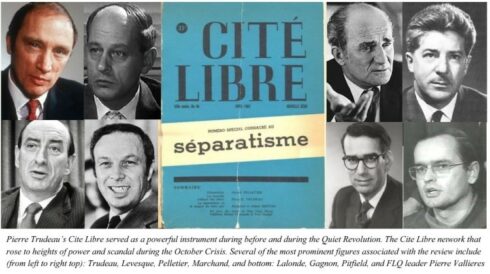
Within merely five years of this transfer of editorship of Cité Libre, Vallières was credited for leading Quebec into a state of crisis, while Trudeau (by now Prime Minister) used the chaos of Vallière’s organization as an excuse to implement the greatest psychological trauma on the Quebec population in history by declaring Marshall Law. This act also served to break the will of may Gaullist forces who were still resisting the technocratic Fabian reforms as late as 1970.
Several other Cité Libre operatives who rose to prominence in Quebec or Federal politics leading up to or after the October crisis include René Levésques, founder of the Parti Quebecois, Gérard Pelletier, Jean-Louis Gagnon, Marc Lalonde, Jean Marchand and Jean-Pierre Goyer.
Jean-Pierre Goyer was a frequent contributor to Cité Libre becoming an MP alongside Trudeau, Marchand and Pelletier in 1965, and then becoming appointed Solicitor General by Trudeau, overseeing the entire RCMP during the October Crisis. When the RCMP became too scandal ridden to be of any use, having been caught creating FLQ cells, robbing dynamite, conducting extortion and theft throughout the 1970s, Goyer played an instrumental role in creating CSIS alongside Trudeau`s right hand man and Privy Council Clerk Michael Pitfield in 1984. Pitfield himself had been active with the Cite Libre nest in the early 1960s translating the group’s influential “Manifesto pour une politique fonctionelle” of April 1964.
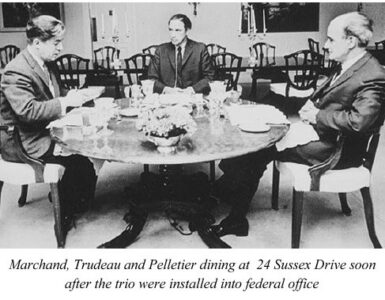
Jean-Louis Gagnon not only served as Managing editor of La Presse (alongside Gérald Pelletier), but Deputy Cabinet Minister and then head of Information Canada under Trudeau during the period of the October Crisis, while Gérard Pelletier was appointed Pierre Trudeau`s Secretary of State. The Oxford trained Marc Lalonde became Principle Secretary to Trudeau (and later his Justice Minister), Jean Marchand (who was dubbed by the Quebec press as one of the “Three Doves” (Pelletier and Trudeau being the other two) also became a Cabinet minister during this period. The vast majority of Cité Libre figures who rose to prominence were members of the Fabian Society’s Cooperative Commonwealth Federation (renamed NDP in 1960) before joining the Liberals.
This is the same group that brought in a cybernetics overhaul to the Canadian government [3] as well as the Malthusian Canadian branch of the Club of Rome, whose Privy Council sponsorship under Trudeau, Pitfield and Lalonde directed government funds to the study which later came to be called Limits to Growth (1972). It was this fraudulent work that became the gospel of the neo-Malthusian revival and was used to justify the “post industrial paradigm of depopulation, and empire.
As you will come to realize in due course by the mere presentation of the elementary facts regarding the October Crisis of 1970, everything you have ever been told about the FLQ and the greater October Crisis which resulted from their activities is a lie.
Endnotes
[1] The personalist ideology which formed the basis of Cité Libre was built around the thinking of Jacques Maritaine and Jean Mounier. Maritain and Mounier were part of the “Catholic” variety of the discrete collaborators with Vichy during WWII, after the integrist Pope, Pius XII, had signed a Concordat deal with Hitler. Maritain was an Ultramontane integrist type of fascist who revived Thomas Aquinas with the purpose of instituting a “New Middle Ages” with the collaboration of the Dominicans. Maritain and Mounier were the leaders of the very Catholic “Ordre Nouveau” under Vichy. (See Pierre Beaudry’s Synarchy report on the DOMINICAN FASCIST YOUTH MOVEMENT in Book II: The Modern Synarchy Movement of Empire www.amatterofmind.org/Pierres_PDFs/SYNARCHY_I/BOOK_II/2._SYNARCHY_MOVEMENT_OF_EMPIRE_BOOK_II.pdf.) Maritain was the most important French philosopher of the war years in France and later in America. The entire Maritain, Mounier, and Reginald Garrigou-Lagrange salon at Meudon was anti- De Gaulle, during and after the war. They were “Catholic personalist communitarians” who oriented against individualism and materialism for the benefit of the Revolution Nationale of Petain.
[2] Before 1960, the New Democratic Party was known since its 1933 creation as the Cooperative Commonwealth Federation (CCF). The CCF was created as the political party of the League of Social Reconstruction, founded in 1932 by six Oxford Rhodes Scholars (F.R. Scott, Eugene Forsey, King Gordon, Escott Reid, David Lewis and Graham Spry), and two Fabians (Frank Underhill and Leonard Marsh). The purpose of the LSR and its spawn CCF was to implement a scientific dictatorship under the model set forth by H.G. Wells as a “solution” to the great depression of 1928-1933. It is thus not a coincidence the first CCF leader J.S. Woodsworth was a leading advocate of eugenics. F.R. Scott became a leading recruiter and lifelong controller of Trudeau upon the laters’ return to Canada in 1950. The LSR, CCF leadership worked closely with the Canadian Institute for International Affairs and founded the Canadian Forum.
[3] Speaking of his love for Cybernetics and systems analysis at a Harrison, Ontario Liberal Conference on November 21, 1969, Trudeau said:
“We are aware that the many techniques of cybernetics, by transforming the control function and the manipulation of information, will transform our whole society. With this knowledge, we are wide awake, alert, capable of action; no longer are we blind, inert powers of fate.”
It was Trudeau, Pitfield, Lalonde, Maurice Lamontagne and Rhodes Scholar Governor General Roland Michener, along with a batch of Malthusians from the Privy Council Office who founded the Club of Rome Canada in 1970 which established the zero growth depopulation agenda which would be pursued for the next 40 years by the oligarchy.
The October Crisis of 1970: A Carefully-Prepared Plot
By Benoit Chalifoux and Matthew Ehret-Kump
The list of structures and institutions that follows shows clearly that some in official circles had anticipated the October 1970 crisis, which crisis had been concocted to lead into the War Measures Act and a consolidation of power in the hands of the “new technocratic elite” that had taken control of the Quiet Revolution after the death of Quebec Premier Daniel Johnson in 1968 and the ouster of both Jean Lesage and Charles de Gaulle from political power in 1969.
The purpose of the following report, which relies heavily upon accounts by Pierre Vallières, taken from his 1977 book L’exécution de Pierre Laporte, les dessous de operation Essai (Editions Quebec-Amériques, 1977) , is not to establish the cause of the October Crisis, but to sufficiently demonstrate that the official narrative commonly used to explain this period is not true. Not only that, but as the facts will show, the cause of these terrible events were organized by more powerful institutions both within and above the Canadian government.
At the Federal Level (Ottawa)
- Based at Ottawa, the Strategic Operations Centre (SOC), was the channel from the army to the Trudeau Government. Its existence became publicly known only in 1975, like that of the Centre national de planification des mesures d’urgences (C.N.P.M.U.), that worked closely alongside the SOC. In the light of what we now know, one can well imagine that the tasks of those centres was to draft, and implement, scenarios that could lead to promulgating the War Measures Act.
- Establishment of the Comité du 7 May 1970: set up by the Federal Government in the wake of the elections on April 29th 1970, as we shall shortly see. The decision was disclosed only on December 23rd 1971, by the Toronto daily The Globe and Mail.
In Quebec
- Opération Essai (Operation Trial), derived from an initial plan, first drafted in 1960, by the Planning and Operations Section of the Quebec Command. That same year, 1960, Jean Lesage became head of the Quebec Government, and launched the «Quiet Revolution» which was a process that had a bipolar character. This process became a key battle ground between two opposing forces. The first had aimed at installing a technocratic elite in Quebec while secularizing the province in preparation for a new Malthusian culture that could be reconstructed to the will of the oligarchy. The opposing force was represented by those nation-building, largely Catholic forces then centered around Lesage and Daniel Johnson who desired to direct the revolutionary energy then embracing Quebec around an anti-imperial strategy of republicanism and technological progress.
- 1966: the Infantry, Air Force and Navy were regrouped, and a new Mobile Army Command was set up at the Federal Military Base of Saint-Hubert.
- 1969: the Mobile Army Command set up its Civil Emergencies Section, whereby contacts with the army were to be restricted to carefully selected political figures.
- 7 June 1970: Michel Côté, the City of Montreal’s Head of Litigation, was secretly appointed to head the Combined Anti-terror Team – Escouade combinée anti-terroriste or C.A.T.. His job was to keep an eye on Jean Drapeau, then Mayor of Montreal.
Chronology of the October 1970 crisis
The chronology below challenges the official thesis, and points up a great many contradictions.
- 1966: Daniel Johnson is elected Quebec Premier giving the anti-Malthusian catholic forces a new opening to regain their lost power on the continent. This coincides with the rise of Robert F. Kennedy to greater prominence in preparation for his 1968 announcement of his plans to revive his brother`s policies in his bid for the Presidency.
- 1967: Charles de Gaulle visits Quebec on Johnson’s invitation at which point deals are struck between the two leaders based on advanced technology, infrastructure, space technology and cultural programs. Many components of this arrangement were based upon the French-Quebec assistance of technology and training to former African colonies now gaining their independence. The French President was invited to return at the end 1968 for the Francophone Summit.
- 26th September 1968: Daniel Johnson dies under unusual circumstances mere hours before the unveiling ceremony of the Manicouagan-5 Dam that Johnson had put into motion a decade earlier alongside then Premier and nation builder Paul Sauvé. Officially, he suffered a fatal heart attack. By 1969, De Gaulle is forced out of office in an anarchistic mock referendum in France. De Gaulle himself had survived over 13 assassination attempts run largely by the Montreal-based Permindex which was also at the center of the assassination of President Kennedy in 1963. Two of the three previous Union National Premiers before Johnson met identical fates and died of heart attacks while in office in a period of 6 months. Maurice Duplessis died on September 7, 1959, while Paul Sauvé died on January 2, 1960.
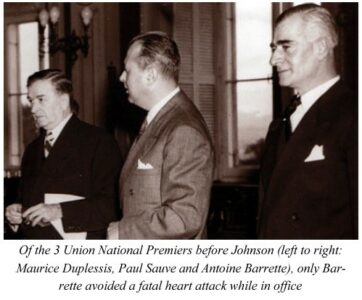
- 1968: Daniel Johnson’s two greatest enemies: Pierre Trudeau and Rene Lévesques, both agents of the of the technocratic reforms of the Quiet Revolution steered by Georges Henri Lévesque’s Université Laval are set up to polarize Canada between two false notions of nationalism and install a new form of Malthusian power structure on both provincial and federal levels. Trudeau is set up as Prime Minister and Lévesques founds the Parti Quebecois (two weeks after Johnson’s death), later to emerge as Premier of Quebec (1976-85). The PQ absorbs many of the saner independence forces who advocated Johnson’s formulation of “Independence if necessary, but not necessarily independence”.
- 1968-1970: violent demonstrations break out in Montreal.
- The Civil Emergencies Section predicts « grave disturbances » during the April elections, and states that the army might have to be called out to « protect the democratic vote ».
- April 29th 1970: Provincial elections held whereby the separatists win 23% of the vote.
- February and June 1970: two kidnapping plots are uncovered by the Montreal police force (police de la Communauté urbaine de Montreal, CUM). One plot, to be launched in June 1970, was to be an FLQ attack on the US Consulate, launched by FLQers Lanctôt and Marcil.
- 27 May 1970: an article in La Presse appears, on the army’s rôle in putting down civil disturbances in Canada. According to the article, military operations were be run out of the Saint-Hubert base.
In Pierre Vallières’ view « by late summer 1970, everything was in place, and liaison between the army and the police forces concerned had moved onto a weekly, sometimes daily basis ». He adds that « by June, the contents of the October manifesto had already been printed in some newspapers, following the abortive ‘Lanctôt-Marcil’ plot against the US Consulate; the FLQers demands had become known, and, finally, the FLQ’s operational bases (save for the flat rented in September in Northern Montreal by Cossette-Trudel) had been dismantled or had become known to the police. The FLQ-1970 was under control in October, and no surprise was possible ».
James Cross is kidnapped
- 5th October 1970: the British diplomat James Cross is kidnapped. The police’s first step is to go straight to the Greek Consul’s place of residence! The kidnappers’ trace is lost. The kidnappers demand that the FLQ’s manifesto be published, and that their political prisoners be freed.
- 7th October: one o’clock in the afternoon. Mrs. Cross is shown police photographs and identifies Jacques Lanctôt as one of the kidnappers.
- 8th October: the FLQ manifesto is published, but negotiations continue over the freeing of political prisoners.
Pierre Laporte is kidnapped: the crisis intensifies
- 10th October (five forty in the afternoon): the Quebec Justice Minister announces that the authorities have decided to categorically reject the demands made by Cross’ kidnappers, nor will they free the political prisoners
- 10th October (six eighteen in the afternoon): Pierre Laporte, Vice-Premier of Quebec and Minister of Labour and Immigration, is kidnapped in front of his home, just as he was about to play ball with his nephew. Pierre Laporte was second in command of the Quebec Government, and as such, was, allegedly, afforded special police protection. But the first thing the police did – having been notified of the kidnapping within two minutes of the event – was, yet again, to go straight to the wrong place!
- Vallière reports that « the six eyewitnesses of the kidnapping of Pierre Laporte (his nephew, his wife and their neighbours) are unanimous: the kidnappers were ‘clean cut’ and well dressed, a fact sergeant Desjardins confirmed to journalists that evening (…) Another witness, who worked in a petrol station on Taschereau boulevard, stated that shortly before the Minister was kidnapped, strangers had asked him how to get to rue Robitaille. ‘I thought they were policemen’, he said, because one was carrying something that looked like a walkie-talkie’ ».
- Night of October 12th to 13th: the Army Mobile Command sends an emissary to Quebec’s Justice Minister, Jérôme Choquette, demanding he sign, in the name of the Bourassa cabinet, a letter requiring intervention by the armed forces. The cabinet was not then prepared to sign, and Choquette announces he would continue his efforts to persuade the reluctant elements.
- 15th-17th October: « for appearances’ sake» the Canadian Parliament debates the opportunity of proclaiming the War Measures Act. The Opposition puts up a show of protest until Saturday October 17th. Pierre Laporte’s body is thereupon discovered, « proving » a posteriori that the measures unleashed on October 16th had been needful.
- 15th October (two in the afternoon): the Canadian army begins to deploy in Quebec, at Bourassa’s request.
- 15th October (nine in the evening): Bourassa ups the ante, and lays down a six-hour deadline for the kidnappers to hand over James Cross and Pierre Laporte.
- 16th October (in the night): Quebec Premier Bourassa signs a letter written by Federal Justice Minister Marc Lalonde, instituting the War Measures Act. Several thousand soldiers were already deployed in the streets of Quebec and in the Federal Capital Ottawa. Through the War Measures Act – whose application need not be voted up by Parliament and that has NEVER been abrogated since – the curfew came down, civil liberties were suspended, and, inter alia, search of private domicile without warrant became lawful. Over four hundred people were arrested.
- 16th October (four in the morning): Meeting in Council, the Governor General, the Queen’s direct representative in Canada, approves the proclamation of a state of emergency, pursuant to which the War Measures Act comes into force automatically.
- 17th October (four in the afternoon): a member of the Cell that calls itself “Dieppe (Royal 22°)” (this is the name of a French Canadian regiment but that was not, oddly enough, at Dieppe in WWII, where many French Canadians died) calls into the CKAC radio station. Purportedly, this is a third and heretofore unknown FLQ cell. The caller announces that Pierre Laporte has been murdered. The earlier communiqués had all come from the FLQ cell known as Libération, that held James Cross, and that spoke on behalf of the Chenier Cell, the members of which were presumed to be the Pierre Laporte’s kidnappers. The Libération cell, that seemed to find the “Dieppe (Royal 22°)” business disturbing, put out a communiqué at mid-day, calling upon the press to blow the whistle on a “montage” (coup monté) by the Federal Government. The police prevented that communiqué from being published until December 8th.
- Pierre Laporte’s body is found in the boot of the very car used to kidnap him (witnesses had taken down the car’s registration number at the time) later in the evening on the Saint-Hubert military base (!), right next to the Army Mobile Command. Given the prevailing State of Emergency, who, I ask, could have driven the car onto the base without being stopped and searched ? Credibility is stretched well beyond the breaking point here.
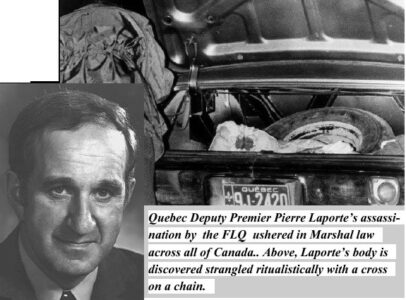
- In the hours following on the death of Pierre Laporte, the authorities put out a description of Paul Rose and Marc Carbonneau, but not that of Jacques Rose, Francis Simard or Bernard Lortie. Paul Rose, Jacques Rose and Francis Simard (presumed to be members alongside Bernard Lortie of the Chénier cell, while Marc Carbonneau and Jacques Lanctôt were part of the Libération cell holding James Cross) had been on police files and monitored since no later than 1968. The three had been in Texas (or perhaps Mexico) since September 1970, and had raced back to Quebec after James Cross was kidnapped. The many trips by Chénier cell members during the time Pierre Laporte was held (and the temporary gaoling of Jacques Rose and Francis Simard between October 15th and 17th) lead one to presume that it could only have been someone quite different keeping watch over the Minister, and that the actual role played by the cell in kidnapping and murdering him was secondary, perhaps even notional.
- 19th October: the house where Pierre Laporte was held and murdered, or so goes the official thesis, is « discovered »: 5630 rue Armstrong at Saint-Hubert, near the aforesaid military base bearing that name. That very house had been ransacked by police whilst the Minister might have been there, but nothing was turned up. Bourassa told Mrs. Laporte on 14th October that the police had found the place her husband was being held: « he will be freed within hours, we await the opportunity to do so without endangering [him] ». The question remains: was that safehouse 5630 rue Armstrong ?
- 2nd November: the Federal Minister John Turner proposes an Emergency Measures Bill, based on the War Measures Act. The Emergency Measures Act was voted up on December 1st and came into force for five months.
- 3rd December: the Emergency Measures Act is signed into law by the Queen. The crisis was, at least apparently, over. Why the fresh Emergency Measures ?
At that very moment, James Cross is freed, and his kidnappers in the Libération cell are given a safe-conduct to Cuba.
- Late December: Paul and Jacques Rose, as well as Francis Simard are arrested. The coroner’s report is based upon unsigned confessions. Paul Rose never acknowledges, not even verbally, the confession attributed to him. Although he was actually firmly in police custody at the time, to avoid any risk whatsoever that he spill the beans in open Court, he was, unbelievably, tried in absentia !
- 31st March 1971: Paul Rose, Bernard Lortie and Francis Simard are sentenced to life imprisonment. Jacques Rose, who was tried later, was acquitted. The Prosecution Service declines to appeal. Jacques Lancôt and Marc Carbonneau were already in exile in Cuba.
If we are to go by the explicit terms of the War Measures Act, the entire country was about to go down in murder and mayhem. The truth is rather different: the FLQ was a tiny, two-cell organisation with a total membership of about ten ! But we read, at Article 2 of the War Measures Act:
“EVIDENCE OF WAR”
The issue of a proclamation by Her Majesty, or under the authority of the Governor in Council shall be conclusive evidence that war, invasion, or insurrection, real or apprehended exists and has existed for any period of time therein stated, and of its continuance, until by the issue of a further proclamation it is declared that the war, invasion or insurrection no longer exists.”
Until 1970, the War Measures Act, first promulgated in 1914, had been proclaimed only twice before: when Canada entered the World War I, in 1914, and World War II, in 1939. Here, we are to take the Governor General’s personal opinion, as “conclusive evidence” of a State of War, that absolutely did not exist.
What did the victim himself think about all this? All that is known for certain, is that in none of his letters to Robert Bourassa whilst kidnapped did Pierre Laporte ever refer to the FLQ, nor did his wife, or most of his friends, ever buy the official story. A Royal Mounted Canadian Police (RCMP) report dated March 3rd 1971 states that Mrs. Laporte’s opinion was that the authorities had executed her husband.
There is a dreadful similarity between the Laporte kidnapping and murder, and that of former Prime Minister Aldo Moro in 1978, down to the detail of the police wandering about in circles in the vicinity of the safehouse. In both cases, subsequent events show that the real intention was never to free the kidnap victim, but to use the crisis to shift the balance of power in the country, in favour of rentier-finance interests.
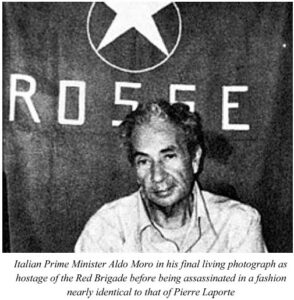
The Material Ease of Terrorists
It is rather astonishing that so many players from that time, have risen to positions of material ease and social prominence. Precisely at the point the synarchy has launched a fresh wave of strategy of tension in Europe and the Americas, they appear to want to keep a tight grip on the main players in the events of October 1970, in order to avoid their disclosing what really went on.
Ex-FLQer Jacques Lanctôt now owns his own publishing house, with a large stock-in-trade on cultural, sociological and psychological issues, and essays on the separatist movement. On March 28th 2004, Télé-Quebec broadcast a documentary called Hostage (Otage), comprised of interviews with Jacques Lanctôt, who kidnapped James Cross, and the Cross family. The documentary was finished in early 2004. Lanctot is now a leading journalist with Canoe Inc. which is owned by Quebecor (whose Vice Chairman is none other than Brian Mulroney)
From 1996 to 2002, Paul Rose had achieved such a miraculous boost of success that he became the head of the Quebec wing of the New Democratic Party of Quebec! This Party merged with the Union des Forces Progresistes which in turn merged with two other organizations to become Quebec Solidaire which currently holds 7.6% of the seats in Quebec’s National Assembly. On March 14, 2013 Quebec Solidaire spokesman MP Amir Khadir introduced a resolution into the National Assembly to honour Paul Rose.
CSIS’s ‘Trudeau Files’ Erased in 1989
On June 15, 2019 the strange fact was made public by Canada’s National Post that the entire 40 year CSIS/RCMP dossier compiled on Canada’s most famous Prime Minister, Pierre Elliot Trudeau was destroyed by Canada’s top spy agency… in 1989.
How this embarrassing fact could have gone un-noticed for so long is tied to access to information laws in Canada which make all government dossiers available on any public or private citizen 20 years after their deaths. In 2019, historians searching for a story filed early applications to read this long awaited dossier which was supposed to be awaiting scrutinizing eyes in the Archives of Canada. The answer they received from CSIS and the National Archives was that the massive treasure of documentation was destroyed because it did not “meet the threshold set out by the CSIS Act to justify being kept in service’s active inventory. The file also fell short of criteria for preservation set out by the national archives”.
Based upon the facts laid bare in the above text and earlier report, it can safely be said that the true reason for CSIS’s destruction of the Trudeau Files had everything to do with devastating information on the role played by Canada’s third longest standing Prime Minister within the context of Britain’s geopolitical “Great Game” against the world.
The role his son is playing as a pawn within this Great Game in carrying out the dictatorial legacy begun by his father 50 years ago can only be understood from this vantage point.
Matthew Ehret is the Editor-in-Chief of the Canadian Patriot Review , and Senior Fellow at the American University in Moscow. He is author of the ‘Untold History of Canada’ book series and Clash of the Two Americas. In 2019 he co-founded the Montreal-based Rising Tide Foundation .






The true story is that the Communist front group FLQ that was planting bombs in people’s mailboxes was connected to the Cuban and Soviet spy agencies.
The KGB and the Cuban Connection – Espionage and Spy Network (1981)
https://youtu.be/8XO1q6omopA
It is allowed to read about trudeau somewhere else.
Whereever i read, I cant recognize this article.
Its only true Canada as many other parts of the lost Brittish Empire had to find themself by reforms. They did.
Mr Trudeu was elected and re-elected many times becuase he handled things well even the needd changes were very difficult.
By that Canada today is high above Russia, Turkey etc. Canada is number 36 in capita in a GDP system. Thats not so bad if they count us to be 226 cointries and and dominians.
I really find it astounding that you refer to “Marshall Law”, as if that’s a proper noun. That doesn’t even make sense. It’s called martial law because it is associated with military occupation, and “martial” is an adjective deriving from the name Mars, the Roman god of war.
What is not know about the crisis and the declaration of martial law, was the direct threat from the president of the United States. The Americans deployed a full air borne division at Plattsburgh Air Force Base. other bases close to the border had American troops deployed. Trudeau was told just before he declared martial law, was for Trudeau to control this insurrection or the United States would invade Canada and crush the insurrection. At that time my brother-in law, was an airforce officier in charge of supply the troops deployed on the base. it was suppose to be a secret, but Jack some times would talk too much when he had too many beers. He is now long time ago dead.